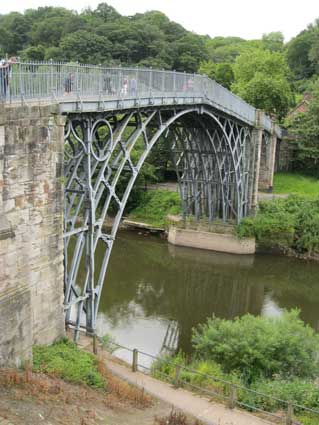
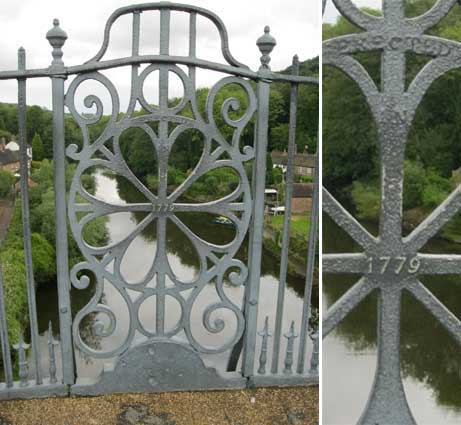 2012
images
2012
imagesThe original Iron Bridge which gives this place its name still stands today, a beautiful curving structure spanning the silvern Severn river. However, once it stood in the most industrialised area in the world – a stinking, smoking, ruined landscape of mining, shipping, foundries and processing – the heart of the Industrial Revolution in England. The cast iron railings on the bridge bear two sets of characters in relief on the upper arc and in the centre of the circular motif:
'ERECTED
... 1779'
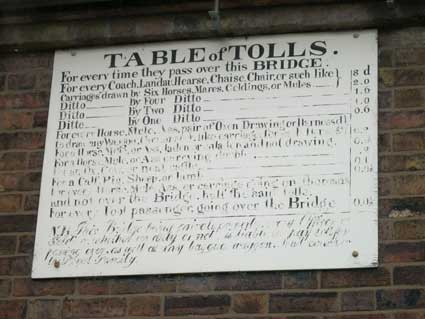
'TABLE OF TOLLS.
For every time they pass over this BRIDGE.
For every Coach, Landau, Hearse, Chaise, Chair, or such like} s d
Carriages drawn by Six Horses, Mares, Geldings, or Mules } 2.0
Ditto ________ by Four Ditto ______________________ 1.6
Ditto ________ by Two Ditto ______________________ 1.0
Ditto ________ by One Ditto ______________________ 0.6
For every Horse, Mule, Ass, pair of Oxen Drawing or Harness'd
to draw any Waggon, Cart or such like carriage, for each Horse &c 0.3
For a Horse, Mule, or Ass, laden or unladen drawing, 0.11/2
For a Horse, Mule, or Ass carrying double, 0.2
For an Ox, Cow, or neat cattle 0.1
For a Calf, Pig, Sheep or lamb 0.01/2
For every Horse, Mule, Ass or carriage going on the roads
and not over the Bridge, half the said tolls.
For every Foot passenger, going over the Bridge 0.01/2
N.B. This Bridge being
private
property, every Officer of
Soldier, whether on duty or not, is liable to pay toll for
passing over, as well as any baggage waggon Mail coach or
the Royal Family.'
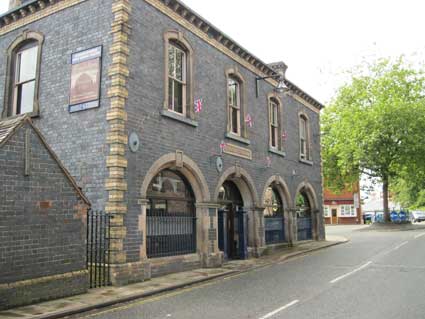
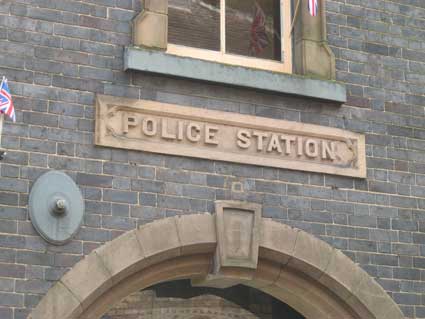
Soldier, whether on duty or not, is liable to pay toll for
passing over, as well as any baggage waggon Mail coach or
the Royal Family.'


Down the slope from the
Iron Bridge, just past a traffic roundabout is a former...
'POLICE STATION'..., in 2012 a
restaurant. Note the inverted 'V' forming the crossbar of the letter
'A'.
One of the more affordable of the ten historical 'attractions' in Coalbrookdale is the Tar Tunnel, close to the Inclined Plain which replaced the tunnel as a mean of lifting cargo boats to a canal. This footbridge spans the river nearby.
One of the more affordable of the ten historical 'attractions' in Coalbrookdale is the Tar Tunnel, close to the Inclined Plain which replaced the tunnel as a mean of lifting cargo boats to a canal. This footbridge spans the river nearby.
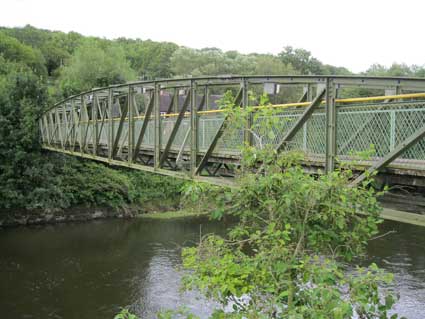
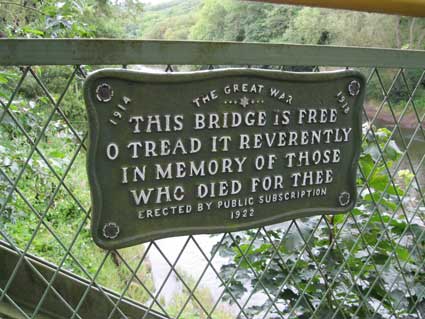

The first plaque
encountered on the footbridge (nearest to the Tar Tunnel) is on the
left above:
'1914
THE GREAT
WAR 1918THIS BRIDGE IS FREE
O TREAD IT REVERENTLY
IN MEMORY OF THOSE
WHO DIED FOR THEE
ERECTED BY PUBLIC SUBSCRIPTION
1922.'
This is a more
decorative plaque with its shaped surround and the font of the main
legend (see the Ancient Egyptian pylon-shaped 'H').
The second plaque reads:
'IN
HONOURED MEMORY OF
OUR COMRADES FROM JACKFIELD AND COALPORT
WHO FELL IN WORLD WARD NOS. 1 AND 2
1914 - 1918
[26 names]
1939 - 1945
[7 names; 1 Missing (in action)]
"THEY SHALL GROW NOT OLD AS WE THAT ARE LEFT GROW OLD,
AGE SHALL NOT WEARY THEM NOR THE YEARS CONDEMN.
AT THE GOING DOWN OF THE SUN AND IN THE MORNING,
WE WILL REMEMBER THEM" '
OUR COMRADES FROM JACKFIELD AND COALPORT
WHO FELL IN WORLD WARD NOS. 1 AND 2
1914 - 1918
[26 names]
1939 - 1945
[7 names; 1 Missing (in action)]
"THEY SHALL GROW NOT OLD AS WE THAT ARE LEFT GROW OLD,
AGE SHALL NOT WEARY THEM NOR THE YEARS CONDEMN.
AT THE GOING DOWN OF THE SUN AND IN THE MORNING,
WE WILL REMEMBER THEM" '
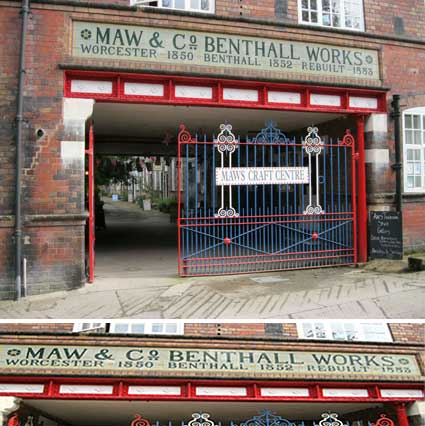

Heading up the path from the country pub near the footbridge on the far side, the long, high brick walls of a works indicates the one-time factory of:
'MAW & CO.
BENTHALL
WORKS
WORCESTER 1850 BENTHALL 1852 REBUILT 1883'
The
manufacture of decorative tiles in Ironbridge Gorge
began with the arrival in 1852 of John Hornby Maw and his two sons,
George and Arthur. They traded as Maw & Co., initially from the
Benthall works on this site and then from a second factory opened in
Jackfield in 1883. Father and sons had moved from Worcester in order to
utilise the Shropshire clays which were perfect for the manufacture of
decorative tiles. Maw & Co. enjoyed a local monopoly until
Hawes
& Denny took over a dilapidated potworks in Jackfield in the
early
1860s. For their first forty years they mainly produced the tiles and
tesserae for which they are best known. In the last decade of the
nineteenth century they started making high quality art pottery. The
help of well known artists such as Lewis Day and Walter Crane was
enlisted for the design of both art pottery and tiles. The company
built up an international reputation and their work was exhibited at
the most prestigious fairs including the Chicago World Fair of 1893.
They were chosen for the execution of decorative work on the Maharaja's
palace at Mysore. Maw & Company continued production at the
Benthall Works until 1967 when they ceased trading.WORCESTER 1850 BENTHALL 1852 REBUILT 1883'
The fine set of iron
gates below the ceramic tile sign opens onto a courtyard which is now
home to all sorts of craft
makers and suppliers' shops. There is also an original doorway with the
tiled sign, complete with pointing finger:
'FOREMAN'S
OFFICE'
OFFICE'
See also Bridgnorth (includes the Severn Valley Railway) and Ludlow.
Return to Historic Lettering from outside Ipswich
Please email any comments and contributions by clicking here.
Search Ipswich Historic Lettering
©2004 Copyright
throughout the Ipswich
Historic Lettering
website: Borin Van Loon
No reproduction of text or images without express written permission
No reproduction of text or images without express written permission